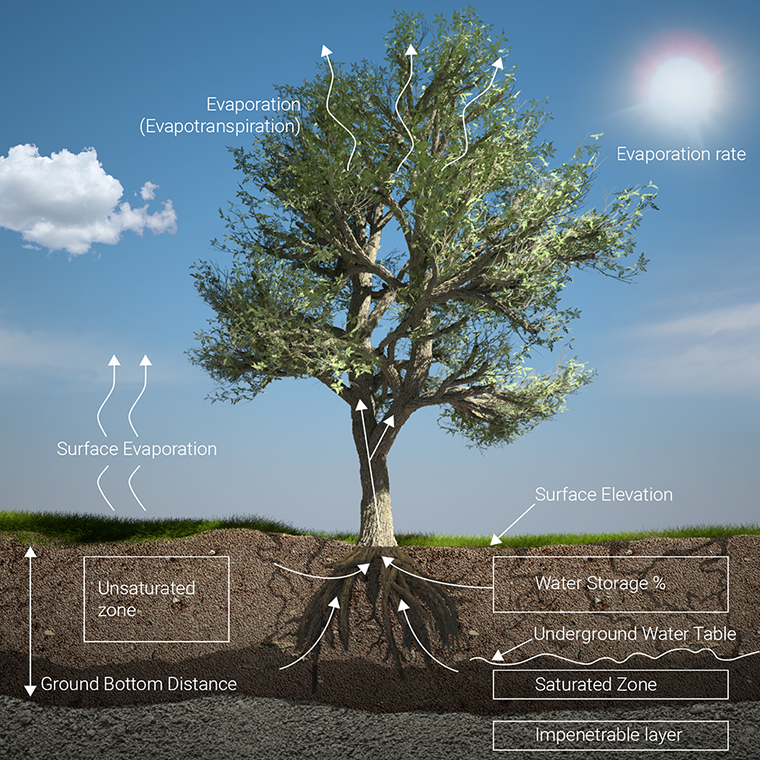Evaporation m (Water Overlay): Difference between revisions
Jump to navigation
Jump to search
No edit summary |
No edit summary |
||
| Line 15: | Line 15: | ||
* A maximum of {{array max|pairs}} can be defined. | * A maximum of {{array max|pairs}} can be defined. | ||
* Internally each period with amount values are converted to an evaporation rate per second at a particular time in the simulation. | * Internally each period with amount values are converted to an evaporation rate per second at a particular time in the simulation. | ||
* The default value is set to 0.125 mm in 2 hours (0.000125 m in 7200 seconds), which corresponds to 1.5 mm per day. This value is derived from the theory described in 2.3 Gewasverdamping<ref name="GWZ2016"/> in the book Grondwaterzakboekje, which combines the formula of Makkink with a temperature dependent factor (which is approximately linear between 0 and 24 C). Based on the plotted lines, it was selected as an average of march, june and september, for a cloudy rainy day, which corresponds to a heavy rainfall event. | * The default value is set to 0.125 mm in 2 hours (0.000125 m in 7200 seconds), which corresponds to 1.5 mm per day. This value is derived from the theory described in 2.3 Gewasverdamping<ref name="GWZ2016"/> in the book Grondwaterzakboekje, which combines the formula of Makkink with a temperature dependent factor<ref name="GWZ2016-2"/> (which is approximately linear between 0 and 24 C). Based on the plotted lines, it was selected as an average of march, june and september, for a cloudy rainy day, which corresponds to a heavy rainfall event. | ||
|seealso= | |seealso= | ||
* [[Water evaporation factor (Water Overlay)]] | * [[Water evaporation factor (Water Overlay)]] | ||
| Line 23: | Line 23: | ||
<references> | <references> | ||
<ref name="GWZ2016">Fig. 2.7 referentiegewasverdamping Gewasfactoren, Bram Bot (2016) ∙ Grondwaterzakboekje, Gwz2016 ∙ Impressed druk en print</ref> | <ref name="GWZ2016">Fig. 2.7 referentiegewasverdamping Gewasfactoren, Bram Bot (2016) ∙ Grondwaterzakboekje, Gwz2016 ∙ Impressed druk en print</ref> | ||
<ref name="GWZ2016">Tabel 2.3 Benadering van <math>\frac{\Delta}{\Delta + \gamma}</math> en <math>\frac{\gamma}{\Delta + \gamma}</math>, Bram Bot (2016) ∙ Grondwaterzakboekje, Gwz2016 ∙ Impressed druk en print</ref> | <ref name="GWZ2016-2">Tabel 2.3 Benadering van <math>\frac{\Delta}{\Delta + \gamma}</math> en <math>\frac{\gamma}{\Delta + \gamma}</math>, Bram Bot (2016) ∙ Grondwaterzakboekje, Gwz2016 ∙ Impressed druk en print</ref> | ||
</references> | </references> | ||
}} | }} | ||
{{WaterOverlay simulation data nav}} | {{WaterOverlay simulation data nav}} | ||
Revision as of 15:43, 28 February 2024
| Attribute | Unit | Description |
|---|---|---|
| EVAPORATION_M | end-time, m | An array of values, each pair indicating until what time that period of evaporation will last and what amount evaporates in that period. |
Notes
- A maximum of 10.000 values (5.000 pairs) can be defined.
- Internally each period with amount values are converted to an evaporation rate per second at a particular time in the simulation.
- The default value is set to 0.125 mm in 2 hours (0.000125 m in 7200 seconds), which corresponds to 1.5 mm per day. This value is derived from the theory described in 2.3 Gewasverdamping[1] in the book Grondwaterzakboekje, which combines the formula of Makkink with a temperature dependent factor[2] (which is approximately linear between 0 and 24 C). Based on the plotted lines, it was selected as an average of march, june and september, for a cloudy rainy day, which corresponds to a heavy rainfall event.







